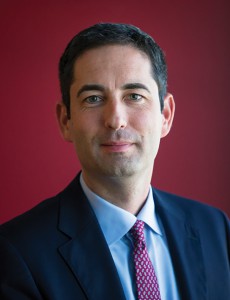Chris Newton-Smith is the chief marketing officer of Redknee. Here, he tells George Malim that monetising the Internet of Things (IoT) is a completely different game to monetising communications service provider (CSP) services. As IoT matures, the correlation between network capacity and application value will continue to erode and systems integrators, app developers and large enterprise IT departments will create new services and apps that will require app-specific monetisation tools and monetisation capabilities.
VanillaPlus: How is the monetisation approach to IoT applications different to that of traditional CSP services?
Chris Newton-Smith: If you look at the IoT applications we’re monetising today, it is clear that not all IoT applications have a CSP focus. Our idea is that as the applications and services of IoT evolve over time, the monetisation requirements and business models will get more interesting and more complex and the companies that build the apps won’t want to build the monetisation capabilities themselves. It will be like the consumer apps marketplace in which app developers don’t build everything themselves – they look at the situation and identify their requirements and then deploy the best-in-class software others have built.
Redknee is good at monetisation, customer management and other adjacent capabilities and we are turning those into a software toolset that anyone can use. That could be CSPs but it could be lots of other types of organisations. For example, we have partnered with Elster, a smart meter company being acquired by Honeywell, to provide a prepaid energy as a service offering that is integrated with their smart meter solutions.
VP: The IoT seems to be at an early stage where organisations haven’t settled down to defined roles in the value chain. What opportunities does that provide Redknee?
CN-S: In terms of the adoption of IoT, it is an early stage market and systems integrators are taking a significant role. For example, we’re engaged in use cases with systems integrators such as our work to provide the monetisation piece for BMW’s Connected Drive offering, which is integrated by T-Systems.
Systems integrators are building new solutions but, as the market develops and becomes more standardised, some companies will build their own apps. If a large enterprise wants to offer a portfolio of services it won’t necessarily need to hire a large systems integrator to build it. Instead they’ll buy a series of best of breed capabilities from providers such as Redknee. At the moment this is an approach that we’re developing.
VP: What about CSPs, what role do you see them playing in the development of IoT?
CN-S: CSPs clearly have a role in delivering the connectivity and they could also provide applications, integration and IoT platforms. In the future, our customers will be broader than the CSP market. Most CSPs are certainly interested in IoT, some see themselves as the systems integrators or platform providers, and others want to bundle IoT services for sale to enterprises.
VP: Is the monetisation approach the same for CSP and IoT services?
CN-S: Not necessarily. The CSP monetisation required right now in some IoT apps is basic. It’s essentially counting the data going back and forth across the network. The value proposition remains the connection – the bits and bytes over the wireless network.
That connection piece is important but the correlation between bits and bytes and the value of the application is very different. That correlation will further break down as IoT applications mature and the value they offer separates further from network capacity. The value of an application is very different to the value of the network capacity. For us, it’s about monetising the application, not just the network.
VP: Given the emerging differences in monetisation approaches and the different nature of the IoT market compared to telecoms, how do you see Redknee changing to address new opportunities?
CN-S: In our telecoms work we mainly engage directly with CSPs from a sales perspective. Our approach in IoT is very different because there are so many opportunities and it’s about partnering with the experts in each vertical in which we can provide monetisation systems. For instance, we have partnered with Elster to address prepaid energy, combining our monetisation product capabilities with their industry knowledge and end-to-end smart metering solution.

It’s mainly a systems integrator-led market on the business-to-business side now. That’s because people are getting familiar with new technology and using systems integrators’ capabilities to learn about the new landscape.
On the consumer side, especially with the start-up culture, there are a lot of companies trying to build new apps. They’re raising money, developing apps and taking them to market and, although many will fail, some will succeed.
The consumer market and the business market require two different approaches. Large enterprises are risk averse and are unclear how it is all going to come together so they will bring in a systems integrator to help them. A few might do it as an internal IT department project where they have the resources, but they are probably in the minority.
VP: Do you see systems integrators, apps stores or internal IT teams as the key channels for Redknee’s IoT monetisation offerings?
CN-S: Selling through app stores and directly to IT departments is a more distant prospect given the immaturity of the market so our approach is to focus on systems integrators and expert partners such as smart meter manufacturers. We’re partner-led in this market today.
I agree with Gartner’s assessment that we’re still in the hype phase of IoT – we’re certainly not in the widespread adoption phase. That means there are requirements roles for systems integrators and other companies. As we move forward, you’ll see many more people building applications using software building blocks from other companies.
For us, it’s important to recognise our market is not the whole market. Our systems address applications that need to be highly scalable and applications and services that have sophisticated monetisation needs. There are many options for companies looking to bill monthly for IoT applications as the barriers to entry are relatively low. We are targeting the areas where Redknee can help to solve unique monetisation problems that organisations face in bringing IoT applications to market.
VP: How will you address those areas and demonstrate the functionality Redknee offers?
CN-S: Our approach is first to find the right partners. Our aim isn’t to work with everyone but to find players with a similar view of the market. We’re working with two or three systems integrators at the moment.
We’re also keeping open in terms of the verticals and applications we’re engaging in. I spoke earlier about our work with BMW in connected cars and our prepaid energy monetisation capabilities. We are working in several different application areas at the moment, with people who have approached us about monetising their applications and services. Redknee is providing the monetisation piece for BMW’s Connected Drive offering.
Chris Newton-Smith, chief marketing officer, Redknee was talking to VanillaPlus magazine’s editor, George Malim.
Comment on this article below or via Twitter: @ VanillaPlusMag OR @jcvplus






